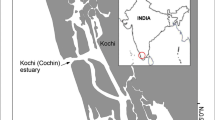Abstract
Numerous headshields of ephippial Chydorus piger (currently called Paralona pigra) females were found from the Holocene sediments of Aitajärvi Lake, northern Finnish Lapland (69° 08′ N, 27° 14′ E). Headshields of ephippial females of the genus Chydorus s.l. can be easily identified since their posterior margin is elongated and pointed. According to analysis of fossil cladoceran remains, Chydorus piger lived in the lake throughout the Holocene but was never very common (less than 10% of preserved cladoceran remains). Headshields of ephippial females were found in most samples and they comprised ca 10–30% of all Chydorus piger headshields. No similar phenomenon was met in Chydorus cf. sphaericus which is common up to the most severe arctic conditions. Aitajärvi is situated north of the modern distribution area of Chydorus piger. I suggest that this species reacted to the stress of harsh climatic conditions outside of its distribution area by being gamogenetic during most of the ice-free period. The ephippial headshields could be valuable indicators of severe climatic conditions in pre-Holocene sedimentary environments.
Similar content being viewed by others
References
Alhonen, P., 1970. The palaeolimnology of four lakes in southwestern Finland. Ann. acad. Sci. fenn. A. III. Geol. Geographica 105: 1–39.
Alhonen, P., 1971. The Flandrian development of the pond Hyrynlampi, southern Finland, with special reference to the pollen and cladoceran stratigraphy. Acta bot. fenn. 95: 1–19.
Atlas of Finland, 1986. Appendix 132, Water. National Board of Survey, Geographical Society of Finland, Helsinki: 31 pp.
Atlas of Finland, 1987. Appendix 131, Climate. National Board of Survey, Geographical Society of Finland, Helsinki: 31 pp.
Atlas of Finland, 1988. Appendix 141–143, Biogeography, Nature Conservation. National Board of Survey, Geographical Society of Finland, Helsinki: 32 pp.
Brancelj, A., 1996. Chydorus mutilus Kreis, 1921-a postephippial form of Chydorus sphaericus (O.F. Müller, 1785). Hydrobiologia 323: 45–59.
Dumont, H.J. & N.N. Smirnov, 1996. Reinstatement of the genus Paralona Stramek-Husek et al., 1962, and assessment of morphological variability in the Paralona pigra-group (Anomopoda: Chydoridae). Hydrobiologia 333: 29–36.
Eronen, M. & P. Huttunen, 1993. Pine megafossils as indicators of Holocene climatic changes in Fennoscandia. Paläeoklimaforschung-Palaeoclimate Res. 9: 29–40.
Ferrari, D.C. & P.D. Hebert, 1982. The induction of sexual reproduction in Daphnia magna: genetic differences between arctic and temperate populations. Can. J. Zool. 60: 2143–2148.
Flössner, D., 1972. Krebstiere, Crustacea. Kiemen-und Blattfüßer, Branchiopoda Fischläuse, Branchiura. Die Tierwelt Deutschlands 60. Gustav Fischer Verlag, Jena: 499 pp.
Frey, D.G., 1980. On the plurality of Chydorus sphaericus (O.F. Müller) (Cladocera, Chydoridae), and designation of a neotype from Sjaelsø, Denmark. Hydrobiologia 69: 83–123.
Frey, D.G., 1982. Contrasting strategies of gamogenesis in northern and southern populations of Cladocera. Ecology 63: 223–241.
Frey, D.G., 1985. A new species of the Chydorus sphaericus group (Cladocera, Chydoridae) from western Montana. Int. Rev. ges. Hydrobiol. 70: 3–20.
Frey, D.G., 1986. Cladocera analysis. In Berglund, B.E. (ed.), Handbook of Palaeoecology and Palaeohydrology. JohnWiley & Sons Ltd., Chichester: 667–692
Goulden, C.E., 1964. The history of the cladoceran fauna of Esthwaite Water (England) and its limnological significance. Arch. Hydrobiol. 60: 1–54.
Green, J., 1966. Seasonal variation in egg production by Cladocera. J. anim. Ecol. 35: 77–104.
Hann, B.J., 1989. Methods in Quaternary Ecology, No. 6. Cladocera. Geosci. Can. 16: 17–26.
Hebert, P.D.N. & T.J. Crease, 1980. Clonal coexistence in Daphnia pulex (Leydig): another planktonic paradox. Science 207: 1363–1365.
Hebert, P.D.N. & B.J. Hann, 1986. Patterns in the composition of arctic tundra pond microcrustacean communities. Can. J. Fish. aquat. Sci. 43: 1416–1425.
Hebert, P.D.N. & D.B. McWalter, 1983. Cuticular pigmentation in arctic Daphnia: adaptive diversification of asexual lineages? Am. Nat. 122: 286–291.
Hyvärinen, H., 1973. The deglaciation history of eastern Fennoscandia-recent data from Finland. Boreas 2: 85–102.
Hyvärinen, H., 1975. Absolute and relative pollen diagrams from northermost Fennoscandia. Fennia 142: 1–23.
Hyvärinen, H., 1987. History of forests in northern Europe since the last glaciation. Ann. acad. Sci. fenn. A. III. Geol. Geographica 145: 7–18.
Hyvärinen, H. & P. Alhonen, 1994. Holocene lake-level changes in the Fennoscandian tree-line region, western Finnish Lapland: diatom and cladoceran evidence. The Holocene 4: 251–258.
Illies, J. (ed.), 1978. Limnofauna Europaea. 2nd edn. Gustav Fisher Verlag, Stuttgart: 532 pp.
Meijering, M., 1983. On the occurrence of ‘arctic’ Cladocera with special reference to those along the Strait of Belle Isle (Quebec, Labrador, Newfoundland). Int. Rev. ges. Hydrobiol. 68: 885–893.
Mäkelä, E., K. Sarmaja-Korjonen & H. Hyvärinen, 1994. Holocene forest history of the Pöyrisjärvi area north of the coniferous tree line in western Finnish Lapland: a pollen analytical study. Bull. geol. Soc. Finland 66: 81–94.
Patalas, K. 1964. The crustacean plankton communities in 52 lakes of different altitudinal zones of northern Colorado. Verh. int. Verein. Limnol. 15: 719–726.
Rautio, M., 1998. Community structure of crustacean zooplankton in subarctic ponds-effects of altitude and physical heterogeneity. Ecography in press.
Reed, E.B., 1962. Freshwater plankton Crustacea of the Colville River area, northern Alaska. Arctic 15: 27–50.
Smirnov, N.N., 1996. Cladocera: the Chydorinae and Sayciinae of the World. Guides to the Identification of the Microinvertebrates of Continental Waters of the World 11. SPB Academic Publishing, Amsterdam: 197 pp.
Stross, R.G. & D.A. Kangas, 1969. The reproductive cycle of Daphnia in an arctic pool. Ecology 50: 457–460.
Tash, J.C. & K.B. Armitage, 1967. Ecology of zooplankton of the Cape Thompson area, Alaska. Ecology 48: 129–139.
Author information
Authors and Affiliations
Rights and permissions
About this article
Cite this article
Sarmaja-Korjonen, K. Headshields of ephippial Chydorus piger Sars (Cladocera, Chydoridae) females from northern Finnish Lapland: a long period of gamogenesis?. Hydrobiologia 390, 11–18 (1998). https://doi.org/10.1023/A:1003507300981
Issue Date:
DOI: https://doi.org/10.1023/A:1003507300981




